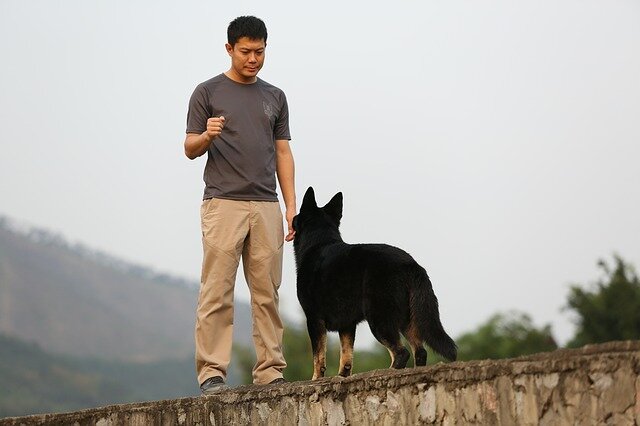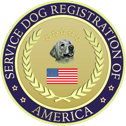5 Signs of a Well Trained Service Dog
2021-06-11
Dogs are awesome, but service dogs are unique.
Service animals, particularly canines, can be life-changing assets for folks with physical disabilities and those suffering from severe mental disabilities or a history of trauma.
But just as not all people qualify for a service animal, not all canines are cut out for the job either.
While they may seem as playful and cuddly as any other pet, service animals are workers with particular jobs to do. Service dogs are responsible for various duties depending on the owner’s needs, ranging from guiding a visually impaired person to calming someone who has PTSD during an anxiety attack.
These immense responsibilities require extensive training and the right demeanor.
So is your service dog showing up for the job as it should be? Here are 5 signs you have the perfect canine candidate.
1. Focused and Task-Oriented
Although many are unaware, service dogs legally do not need to be trained by a professional and can instead be trained by the animal’s owner. While a person with a disability may prefer to partner with or adopt an already trained dog through an agency, many folks opt to train their canine companion independently.
In all cases, but particularly if you plan to train your dog by yourself, it is paramount that the dog is task-oriented and has the ability to remain focused on responsibilities in a variety of settings.
For example, if a dog has the duty to retrieve items for an owner who struggles with mobility, they must remain in tune with their handler’s needs. If the dog gets off task and becomes distracted easily, it can be detrimental to the daily life of the person who relies on the animal. A dog responsible for bringing their owner medicine or reminding their owner when it is time to take certain prescriptions needs to be fully focused. If not, there could be serious—even fatal—consequences.
2. High Tolerance for Noise and Touch
Service dogs need to have a high tolerance for stimuli and remain focused despite sound and sensation grabbing for their attention. It is common knowledge that people are not supposed to interact with another person’s service dog, especially without asking permission. But even service animals with the best behavior may be approached by people, often children, who do not know these rules.
When a service animal goes through thorough training, they are automatically taught not to respond to people other than their owner. They must not get distracted easily. These traits can be fostered through training, but some dogs naturally have a higher threshold than others for external stimuli. It is important to note a dog’s implicit ability to remain attentive in a variety of circumstances while selecting a service companion.
3. Adaptable to Any Environment
Service animals, according to the ADA, are legally allowed to accompany their owners pretty much anywhere. This is essential, as service dogs may need to assist people with disabilities in any setting. Because of this, dogs must receive proper training to adapt to any environment without becoming overwhelmed.
Larger service dog breeds who are tasked with pulling the wheelchair of a person with a disability as they go grocery shopping will need to remain vigilant and navigate crowded aisles and sharp corners. Animals may need to be able-bodied and strong to assist their owner in the necessary environments fully. You can tell a canine has been well-trained if they can problem-solve in any setting to meet their owner’s needs.
4. Good Hygiene and Tidiness Habits
While most folks do not think of animals as being particularly hygienic without an owner’s intentional care, service dogs are trained to have a strong sense of cleanliness and tidiness. In fact, service animals are expected to maintain a high level of hygiene and health at all times. While immunizations and other health upkeep will need a caretaker’s facilitation, daily cleanliness habits can be learned.
Tidiness behavior comes naturally to some canines, but it may take extensive service dog training to perfect in others. Self-grooming, knowing how to wipe their own paws before entering a home, and the ability to pick up after themselves are key. If there are dog toys strewn about a house or bits of kibble scattered on the floor, this can be a tripping hazard to folks who are physically disabled or visually impaired. Through training that uses repetition and reward, dogs can learn to pick up after themselves.
5. Strong Impulse Control
Service animals that have been well-trained exhibit a strong sense of impulse control. They do not bark at passing animals or startle easily when a truck suddenly zooms by. This behavior does not come naturally to many canines but can be instilled through rigorous service dog training and is essential for keeping folks out of danger.
There is a major balance in behavior at play here with service dogs. These companions must be constantly alert and ready to assist their owner but cannot be overly reactive. This is especially true for dogs who partner with folks suffering from severe anxiety attacks. A consistently calm composure is imperative in assisting the regulation of breath in moments of panic and can ensure the owner’s health and safety.
Registering Your Well Trained Service Dog
While you’re busy with service dog training, there are still other boxes to tick to fully register your canine and get them ready for service. But, don’t sweat it!
At Service Dog Registration of America, we have everything you need and professional staff to help the process go smoothly. From registration forms or essential products—like vests, IDs, and leashes — Service Dog Registration of America has you covered. Get in touch with us today to learn how we can help you.
